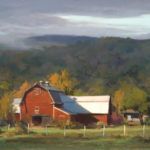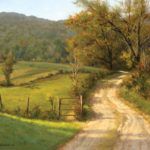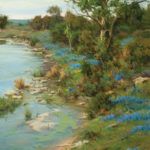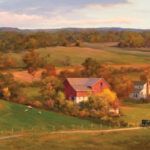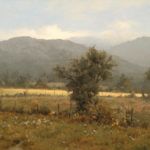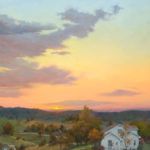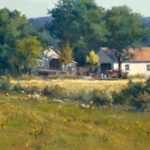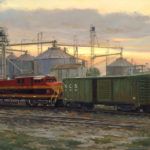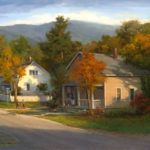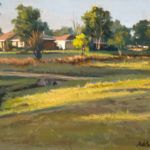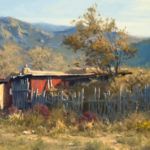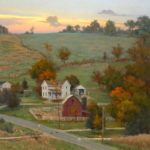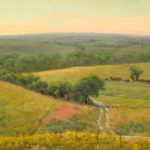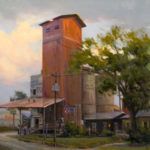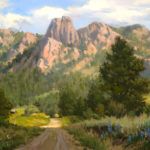John Pototschnik’s paintings recall the tranquil beauty of an earlier time
By Gussie Fauntleroy
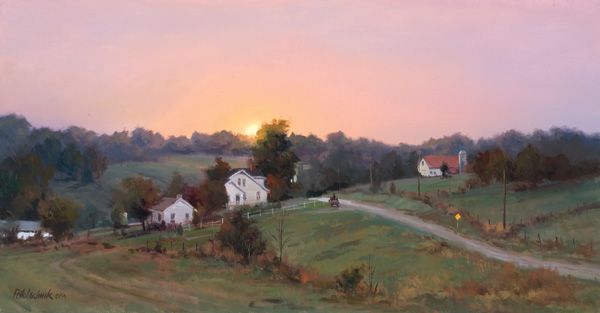
John Pototschnik, Calm Settles Over the Land, oil, 16 x 30.
This story was featured in the October 2019 issue of Southwest Art magazine. Get the Southwest Art October 2019 print issue or digital download now–then subscribe to Southwest Art and never miss another story.
WHEN JOHN POTOTSCHNIK and his wife were raising their two sons on a few acres near Wylie, TX, in the 1980s, the boys could play freely in the nearby woods and along a creek. Cars were a rare sight along the two-lane road. The Pototschniks’ home had the country feeling they were looking for after having lived in a Dallas suburb, where the artist had a successful career as a freelance commercial illustrator. Over the decades since then, population has increasingly encroached on Wylie, a half-hour northeast of Dallas. The road has gone from two to four lanes and soon will be six. Subdivisions have multiplied. A nearby 56-acre open space is up for sale.
It’s no surprise that Pototschnik (pronounced poe-TOE-shnick) creates paintings that recall rural or small-town life from an earlier time—or that viewers and collectors are drawn to his vision of an uncluttered, human-paced world. The tagline for his art, “paintings of the America we all love,” reflects the fact that “We all want a life of joy and peacefulness, a less complex life,” he says. Capturing that feeling are paintings like BE STILL MY SOUL, a quiet landscape dotted with wildflowers whose title comes from a Christian hymn. The painting earned a Silver Medal in the 2018 Oil Painters of America National Juried Exhibition, and this year it won Best of Show in the National Oil and Acrylic Painters’ Society Spring International Online Exhibition.
- John Pototschnik, Vermont Barn, oil, 12 x 16.
- John Pototschnik, Staying Home, oil, 16 x 27.
- John Pototschnik, Rural Hideaway, oil, 25 x 28.
POTOTSCHNIK’S depiction of country landscapes and gentle neighborhoods emerges as much from his own boyhood as from memories of his sons’ carefree years. The son of an American serviceman and a British “war bride,” he was born in England just after World War II. The family settled in Wichita, KS, when John was a few months old. Although they lived in town, they often spent time on the farm belonging to relatives in eastern Kansas.
Like many kids of his era, his free time to play outdoors was balanced with a strong work ethic instilled by his parents. “My parents were quite strict and expected us to use our time wisely,” he remembers. That meant having two paper routes and jobs mowing lawns and shoveling snow, as well as daily household chores. Without a car as a teen, he rode his bicycle to school and anywhere else he wanted to go. Those habits stayed with him through the years and served him well in various aspects of his life—as a highly competitive bicycle racer for 15 years, as a commercial illustrator meeting tight deadlines, and as a fine-art painter putting in studio hours each day.
While he was not exposed to fine art growing up, Pototschnik liked working with his hands to assemble model airplanes and cars and to draw cars and planes. His classmates’ enthusiastic response to his drawings encouraged him to join the high school poster club, where he put his budding art skills to use. Still, he had no idea that art could be a profession. “I just enjoyed doing it,” he says. When he entered college, he planned to study business but quickly realized it was not a good fit, and by the middle of his freshman year he was ready to switch. On the advice of a guidance counselor, he began taking art classes and discovered that his boyhood interest had a place in school, and perhaps beyond, after all. “I thought, I really like doing this, let’s do this!” he recalls.
- John Pototschnik, Nature’s Subtlety, oil, 28 x 22.
- John Pototschnik, Land of Abundance, oil, 35 x 65.
- John Pototschnik, Be Still My Soul, oil, 30 x 40.
As an art major at Wichita State University, Pototschnik initially imagined a future as a painter. But it was the era of abstract expressionism, and nothing he heard from the school’s painting instructors and fellow students seemed to match his own understanding of fine art. “It was completely undisciplined. They were all saying, just do your own thing [with paint]. It made no sense to me,” he says. “So I thought, okay, I’ll focus on commercial art.” At first he considered aiming for a career as an art director, designing ads. But the more familiar he became with the great illustrators of the day—Mark English, Bob Peak, and Bernie Fuchs among them—the more he fell in love with their work and aspired to become an illustrator himself. In 1968 he graduated with a Bachelor of Fine Arts in advertising design. Meanwhile he had become a competitive cyclist, winning local, state, regional, and national races. After college he joined the Air Force as a commissioned officer and was stationed in California, where many of the Armed Forces athletes were training for the 1968 Olympic trials. While training for races, he served as an Air Force information officer and took night classes at the Art Center College of Design in Pasadena. His cycling eventually took him to the World Championships in Leicester, England.
After leaving the military, Pototschnik moved to the Dallas area with his wife, Marcia, and spent 10 years as a freelance commercial illustrator, primarily in advertising. Working with major corporations and Dallas-area businesses, his art skills went toward products and projects as diverse as Dr. Pepper, Haggar clothing, jewelry, storyboards for television commercials, and the Dallas/Fort Worth International Airport. Each assignment was an exercise in the creative visual interpretation of an idea. It also called on the strong self-discipline he’d learned as a boy and employed in racing. “Illustration was great preparation for fine art because there are deadlines, and when things are not going well, you have to figure out problems and solutions in a short time,” he says.
- John Pototschnik, A Long Way to the Store, oil, 50 x 40.
- John Pototschnik, At the Edge of Town, oil, 24 x 30.
- John Pototschnik, Family Roots, oil, 12 x 24.
By the late 1970s, Pototschnik began seeing big changes in the commercial art world. Photography and computers were rapidly replacing hand illustration, and many of the most respected illustrators were leaving the field. Artists like Kenneth Riley, Howard Terpning, Tom Lovell, and Tony Eubanks were shifting into fine-art painting. “One after another, I just kept noticing major illustrators leaving,” Pototschnik says. “I always wanted to do fine art, and I thought: They’re doing it, maybe I can also.”
In 1982, he did. In the studio at his Wylie home, he turned to subjects that reflected his boyhood and love of rural life. “Once you have the freedom to paint whatever you want, you get in touch with things that have meaning for you—you begin painting from the heart,” he says. Soon afterward, a comment by a local gallery owner brought him up short. Looking at one of his paintings, the gallerist said, “You’re an illustrator, aren’t you?” It was the last thing Pototschnik wanted to hear. It meant that he was still using an illustrator’s palette—too bright for a naturalistic effect—and incorporating unnecessary detail. Around the same time, Eubanks urged him to paint outside on location, and that advice transformed the way he observes and paints.
Since then, a significant focus of Pototschnik’s work has been learning, refining, and teaching the use of color. He has led numerous workshops in which he demonstrates how a rich array of color can be produced from a very limited palette—often just three primary colors. To share this knowledge, the artist created a book, Limited Palette, Unlimited Color, along with an instructional DVD, Create Unlimited Color with a Limited Palette, both published in 2019 and available on his website. He also shares the insights and experiences of his fellow artists through an ongoing series of interviews he conducts and publishes on his blog; to date he’s done almost 90 of them.
- John Pototschnik, Kansas City Southern de Mexico, oil, 24 x 36.
- John Pototschnik, For a Moment, All the World was Right, oil, 30 x 40.
- John Pototschnik, My Neighborhood, oil, 7 x 9.
While color and value remain central to Pototschnik’s art, especially in expressing emotion and mood, his imagery has shifted in subtle ways over time. Early on he was inclined to paint exactly what he saw, which was often straightforward rural landscapes with houses and barns. In more recent years, he finds a spark of something compelling in a scene and then modifies it to create the timeless feeling of a simpler world, the world of his memories and one in which he and others would like to live.
CALM SETTLES OVER THE LAND is one such piece. The artist transformed an average-looking midday country scene into a serene and restful sunset scene. He kept the old farmhouses and layered hills but removed extraneous elements, allowing the viewer to be transported back in time. And he added a figure on a tractor, slowing the pace even more. “My paintings have a subtle narrative that tells the story of people living in the area, which makes it more human,” he says. Other paintings tell stories of community—neighbors visiting on a sidewalk or kids shooting hoops in a driveway, often with 1950s-era cars parked nearby. Still others are pure landscapes, yet with a composition and quality of light that speaks of quiet and ease.
- John Pototschnik, Of the Land, oil, 12 x 16.
- John Pototschnik, Saturday Afternoon Game, oil, 16 x 20.
- John Pototschnik, Texas Hill Country, oil, 16 x 20.
Although Pototschnik’s own surroundings are much less quiet than when he and Marcia first built their home, he seeks out and finds country settings where he can walk and hear the birds and wind. Or he spends time working in his yard. “It gets me in a contemplative mood,” he says, and then smiles. “If I wasn’t an artist, I wouldn’t mind being a farmer or gardener. That’s probably why I paint what I do.”
representation
Abend Gallery, Denver, CO; Highlands Art Gallery, Lambertville, NJ; Illume Gallery of Fine Art, St. George, UT; Mary Williams Fine Arts, Boulder, CO; Southwest Gallery, Dallas, TX; Wylie Fine Art Gallery, Wylie, TX; www.pototschnik.com.
- John Pototschnik, The Calm Descends, oil, 50 x 40.
- John Pototschnik, The Endless Prairie, oil, 36 x 60.
- John Pototschnik, The Old Mill, oil, 16 x 16.
- John Pototschnik, Twin Owl Guardians, oil, 18 x 24.
This story was featured in the October 2019 issue of Southwest Art magazine. Get the Southwest Art October 2019 print issue or digital download now–then subscribe to Southwest Art and never miss another story.
MORE RESOURCES FOR ART COLLECTORS & ENTHUSIASTS
• Subscribe to Southwest Art magazine
• Learn how to paint & how to draw with downloads, books, videos & more from North Light Shop
• Sign up for your Southwest Art email newsletter & download a FREE ebook






